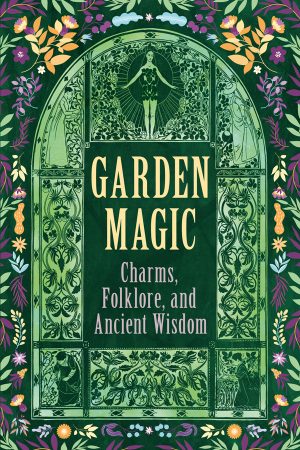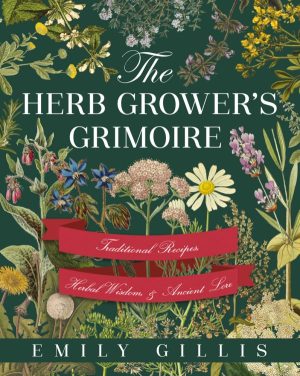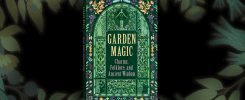Herbs and plants have long offered natural medicines and remedies for all manner of ill-health, drawing on centuries of folk knowledge and plant lore. In this blog for green thumbs, we turn to the healing power of plants and reveal the most helpful herbal remedies for gardeners to soothe the minor injuries and discomforts that can arise from working closely with the earth.
Magic is a general name for wonderful effects produced in some mysterious way. Medicine, in its early form, is intimately allied to magic. In modern times, drugs are mostly drawn from the mineral and vegetable kingdoms; but while the healing art was in the mystic stage, animal substances were most esteemed.
In early stages of society, women are the doctors; while the men fight and hunt, the women gather herbs and decoct salves for their wounds; and the art would naturally become a sort of profession in the hands of the older women who had a reputation for superior skill of that kind.
The ‘wise woman’ with her kettle, cooking her mysterious broth, adding ingredient after ingredient, inspired not only hope but fear; for the art might be, and doubtless was, used to hurt as well as to heal.
‘A poison-maker’ was the Roman name for a preparer of magic medicines, an enchantress or sorceress—the corresponding character to our witch.
(Chambers, 1875)
Gathering Plants for Medicine
All herbs should be gathered when in full flower and when perfectly dry. They should then be well dried in the Sun. For storage they should not be tied in bundles but kept in paper bags in dry places so that the herbs may retain their fragrance and colour as much as possible. For those who follow astrology the gathering of the herbs should be done at a time when the planet governing them is rising and angular.
When leaves only are required, they should be gathered when dry and fully grown. They should then be thoroughly dried in the Sun and protected from night air. When they have lost their colour or scent, or have become inert, they are no longer fit for use. For those who follow astrology the leaves should not be gathered when the planet ruling the plant is in the Tenth, Eleventh or Twelfth House.
Tree barks should be gathered in the Spring when the sap is rising and the bark peels off easily. It is advisable not to gather more bark than what is needed for immediate use.
When roots are required they should be dug up when the plants have finished growing, cut into pieces and after they have been well dried, preserved in tins with tightly fitting lids and lined with paper. (Culpeper and Simmonite, 1957)
Herbal Remedies for Gardeners
The following magical herbal remedies are included as gentle, restorative balms for common gardening ailments such as nettle stings, blisters, and splinters. These honour the reciprocal relationship between the gardener and the garden.
For Mood Boosting, Inflammation, and Anxiety
Gather the flowers of the hundred-leaved rose (rosa centifolia), put them in a large jar or cask, with just sufficient water to cover them, then put the vessel to stand in the Sun, and in about a week afterwards the otto (a butyraceous) oil will form a scum on the surface, which should be removed by the aid of a piece of cotton. Known for mood-boosting, inflammation and anxiety.
(Jones, 1861)
An Aromatic Bath for the Feet
Take four handfuls of Pennyroyal, Sage, and Rosemary, three handfuls of Angelica, and four ounces of Juniper Berries; boil these ingredients in a sufficient quantity of water, and drain off the liquor for use.
(Buc’hoz, 1784)
For Burns, Scalds, and Sore Muscles
Take 1 pound of Burgundy Pitch; 1/2 pound each of Beeswax and Hog’s Lard. Simmer over a slow fire till all are well mixed together, then stir it well till cold.
(Culpeper and Simmonite, 1957)
For Cuts and Bruises
1 ounce of Spirit of Wine and Camphor; 1 ounce of Oil of Turpentine; 1 ounce of Saltpetre; 1 ounce of common Salt; a gill of good Vinegar. Mix well and keep it for use. Excellent.
(Culpeper and Simmonite, 1957)
To Stop Nose Bleeds
Blue Cornflowers gathered on Corpus Christi Sunday stop nose-bleeding if they are held in the hand till they are warm.
(Folkard, 1884)
For nosebleed wear a red bean on a white string round the neck.
(Bergen, 1899)
To Stop Itching
Take of Flowers of Sulphur, 2 ounces; Hog’s Lard, 4 ounces; Oil of Lavender; 60 drops, mixed. To be well rubbed on the parts affected every night, till the eruption ceases to be troublesome.
(Culpeper and Simmonite, 1957)
For Headaches or Menstrual Pain
Being slightly stimulating, tonic, and resolvent, Rosemary is generally used as an adjunct to other sternutatory powders, etc. The Oil of Rosemary, Oleum rosemarini, is obtained by distillation from the tops of the dried plant; it is a stimulant.
Dose.—Of the powdered leaves take 10 grains with as much ginger, or with 5 grains of Capsicum.
Use.—For the above disease. Take from 2 to 6 drops on castor sugar.
(Culpeper and Simmonite, 1957)
To Relieve Stomach Pain
Green Wormwood placed in the shoes will relieve pains in the stomach of the wearer.
(Folkard, 1884)
For Nettle Stings
When badly stung with nettles, you take a few leaves of dock dockon (rumex obtusifolius), spit on them, and rub the place with them, uttering the words: ‘In dockon (elsewhere: dock), out nettle!’ In Chaucer’s Troil: ‘Nettle in, dock out.’
(Grimm and Stallybrass, 1888)
To Cure Bee Stings
Immediately after taking out the sting, get an onion and bruise it, and apply it to the stung place, and it will afford immediate relief. Or a washerwoman’s blue bag, applied in the same manner, will have a like effect.
(Jones, 1861)
To Draw Out Splinters and Thorns
The roots of white Briony, bruised and applied to any place, when the bones are broken, help to draw them forth, as also splinters, arrow-heads, and thorns in the flesh.
The root of an Iris, if it grow upwards, will attract all thorns from the flesh.
(Folkard, 1884)
For Trouble with the Eyes
Take nine grains of barley, and put them in a black pot with nine flowers of elder and nine bits of rue. Boil them for a quarter of an hour, then let it cool till it is tepid. Then dip into it a piece of linen and lay it on the eyes of the patient, and then take the nine grains of barley and the elder flower and the rue, and lay them all on the cloth, and say—
All of this I have had boiled
To put upon the eyes,
Of this poor man—Saint Lucy aid!
And on the third day, by thy aid,
He will in health arise!
Santa Lucia is the saint of light, therefore of sight. The two were identified in ancient Roman mythology.
(Leland, 1892)
To Heal Open Wounds
The root of an Iris, if it inclines downwards, it will cure wounds.
(Folkard, 1884)
A piece of Oak, rubbed in silence on the body, on St. John’s Day, before the Sun rises, heals all open wounds.
(Folkard, 1884)
To Stop Pain and Sickness
For sickness and pain, take Parsley, Fennel, Anise, and Carraway Seeds, 1 ounce; Roots of Parsley, Burnet, Saxifrage, and Carraways, 1/2 ounce. Boil in 2 pints of water down to 1, then strain; and take a cupful two or three times a day.
(Culpeper and Simmonite, 1957)
For Corns on the Feet
Roast a Clove of Garlic, or an Onion, on a live coal or in hot ashes, apply it to the corn, and fallen it on with a piece of cloth. This softens the corn to such a degree, as to loosen and wholly remove it in two or three days. Foment the corn every other night in warm water, after which renew the application.
(Buc’hoz, 1784)
These ancient herbal remedies were taken from our beautiful grimoire Garden Magic. Explore more of the wonderful magical properties and healing powers of plants in our thoughtfully curated collection, exploring what makes the garden such a magical space.
If you enjoyed this small collection of herbal remedies, you might also like our beautifully illustrated Herb Grower’s Grimoire, a complete herbal of ancient knowledge and magic.




